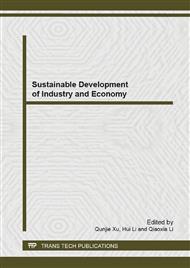[1]
Zhang WF, Dou ZX, He P, et al. New technologies reduce greenhouse gas emissions from nitrogenous fertilizer in China. PNAS. Vol. 110(2013), pp.8375-8380.
DOI: 10.1073/pnas.1210447110
Google Scholar
[2]
Hillier J, Hawes C, Squire G, et al. The carbon footprints of food crop production. International Journal of Agricultural Sustainability. Vol. 7(2009), pp.107-118.
DOI: 10.3763/ijas.2009.0419
Google Scholar
[3]
Lal R. Carbon emission from farm operations. Environment International. Vol. 30(2004), pp.981-990.
DOI: 10.1016/j.envint.2004.03.005
Google Scholar
[4]
Page G, Ridoutt B, Bellotti B. Carbon and water footprint tradeoffs in fresh tomato production. Journal of Cleaner Production. Vol. 32(2012), pp.219-226.
DOI: 10.1016/j.jclepro.2012.03.036
Google Scholar
[5]
Peters G P. Carbon footprints and embodied carbon at multiple scales. Current Opinion in Environmental Sustainability. Vol. 38(2010), pp.4856-4869.
DOI: 10.1016/j.cosust.2010.05.004
Google Scholar
[6]
Cheng K, Pan GX, Pete S, et al. Carbon footprint of China's crop production-An estimation using agro-statistics data over 1993–2007. Agriculture, Ecosystems & Environment. Vol. 142(2011), pp.231-237.
DOI: 10.1016/j.agee.2011.05.012
Google Scholar
[7]
Shi LG, Chen F, Kong FL, et al. The Carbon Footprint of Winter Wheat-Summer Maize Cropping Pattern on North China Plain. Chinese Journal of Population Resources and Environment. Vol. 21(2011), pp.93-98. ( in Chinese with English abstract).
Google Scholar
[8]
West T O, Marland G. Net carbon flux from agricultural ecosystems: methodology for full carbon cycle analyses. Environmental Pollution. Vol. 116(2002), pp.439-444.
DOI: 10.1016/s0269-7491(01)00221-4
Google Scholar
[9]
Meisterling K, Samaras C, Schweizer V. Decisions to reduce greenhouse gases from agriculture and product transport: LCA case study of organic and conventional wheat. Journal of Cleaner production. Vol. 17(2009), pp.222-230.
DOI: 10.1016/j.jclepro.2008.04.009
Google Scholar
[10]
Gan Y, Liang C, Wang X, et al. Lowering carbon footprint of durum wheat by diversifying cropping systems. Field Crops Research. Vol. 122(2011), pp.199-206.
DOI: 10.1016/j.fcr.2011.03.020
Google Scholar
[11]
Bonesmo H, Skjelvåg A O, Henry Janzen H, et al. Greenhouse gas emission intensities and economic efficiency in crop production: A systems analysis of 95 farms. Agricultural Systems. Vol. 110(2012), pp.142-151.
DOI: 10.1016/j.agsy.2012.04.001
Google Scholar
[12]
Dong G, Mao X, Zhou J, et al. Carbon footprint accounting and dynamics and the driving forces of agricultural production in Zhejiang Province, China. Ecological Economics. Vol. 91(2013), pp.38-47.
DOI: 10.1016/j.ecolecon.2013.04.003
Google Scholar
[13]
Mondelaers K, Aertsens J, Huylenbroeck G. A meta-analysis of the differences in environmental impacts between organic and conventional farming. British Food Journal. Vol. 111(2009), pp.1098-1119.
DOI: 10.1108/00070700910992925
Google Scholar
[14]
Shi L G, Fan S C, Kong F L, et al. Preliminary study on the carbon efficiency of main crops production in North China Plain, Acta Agron Sin. vol. 37(2011), pp.1485-1490. ( in Chinese with English abstract).
DOI: 10.3724/sp.j.1006.2011.01485
Google Scholar


